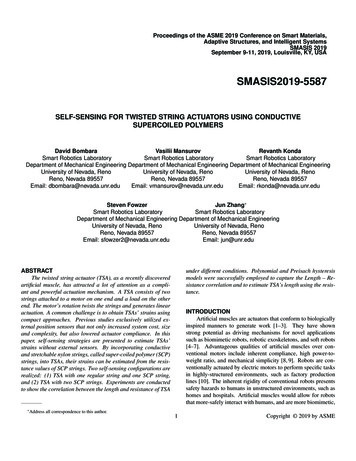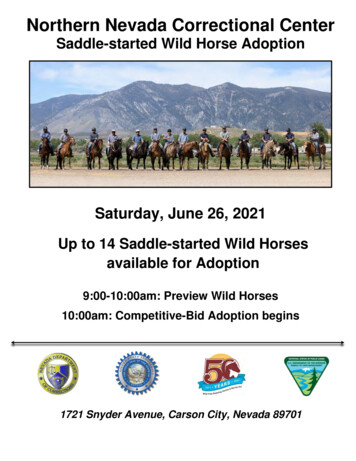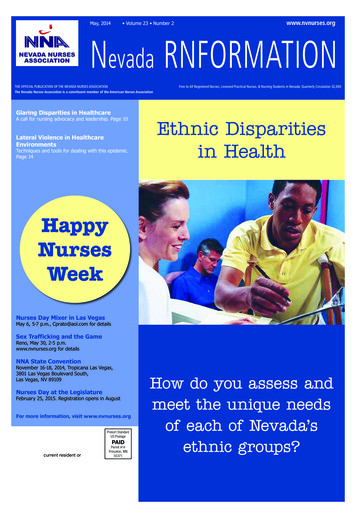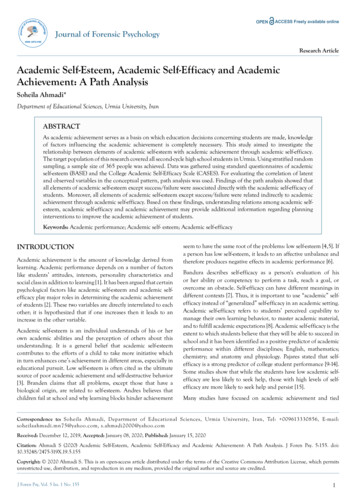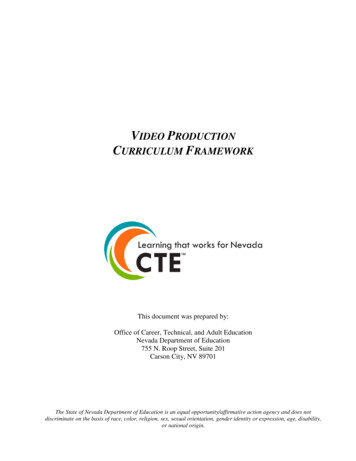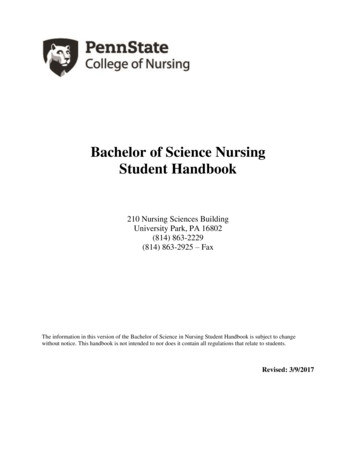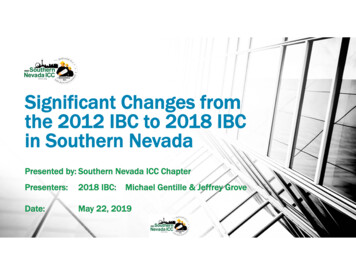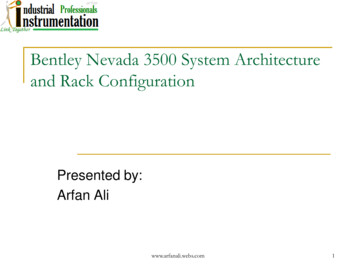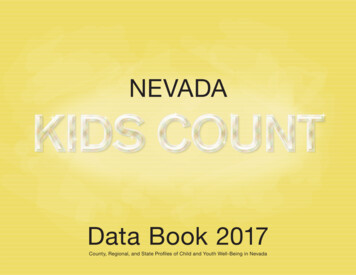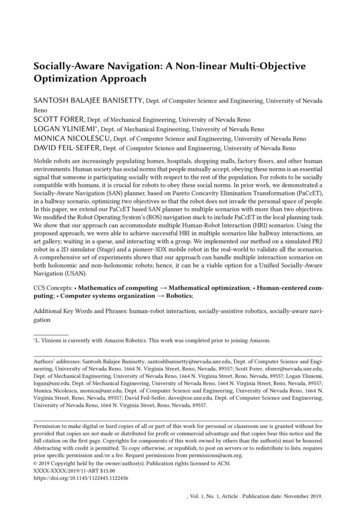
Transcription
Nevada Academic Content Standards forSocial StudiesRevised September 20181
Nevada Department of Education700 East Fifth StreetCarson City, Nevada 89701Dr. Steve CanaveroState Superintendent of Public InstructionBrett BarleyDeputy Superintendent for Student AchievementDave BrancampDirector of the Office of Standards and Instructional SupportMary HolsclawK-12 Social Studies, Content Literacy, and Competency-Based EducationAcknowledgementsAppreciation is extended to the members of the Nevada Social Studies Revision Team for their time, expertise, and dedication toensuring that all students in Nevada achieve excellence in social studies.2
Table of ContentsIntroduction . 4Overview of K-12 Standards. 5Reading the Standards . 5Color Coding of the Standards . 6Disciplinary Skills . 6Content Themes . 7Kindergarten: Building Community – Learning & Working Together . 8Grade 1: The Community We Live In & the Work We Do. 10Grade 2: Our National Identity & Culture . 12Grade 3: Movement Around Our World . 14Grade 4: Nevada: Past & Present. 17Grade 5: The U.S. - Creating a New Nation . 20Grades 6-8: . 23Early World Civilizations (prior to 1500) . 23World Geography & Global Studies . 26Early U.S. History & Civic Ideals . 29Financial Literacy. 33Grades 9-12: . 34World History & Geography (1300-Present). 34U.S. History (1877-Present). 38Civics & Economics . 42Financial Literacy. 47References . 483
Introduction“NOW MORE THAN EVER, students need the intellectual power to recognize societal problems; ask good questions and develop robust investigations into them;consider possible solutions and consequences; separate evidence-based claims from parochial opinions; and communicate and act upon what they learn. Andmost importantly, they must possess the capability and commitment to repeat that process as long as is necessary. Young people need strong tools for, andmethods of, clear and disciplined thinking in order to traverse successfully the worlds of college, career, and civic life.”-The College, Career, and Civic Life (C3) Framework for Social Studies State StandardsSocial studies education is the foundation of our republic, providing all students with the foundation in democratic principles and civic responsibility necessaryto create an enlightened, inclusive, and innovative nation. The standards require a student-centered approach to social studies in which critical thinking andinquiry are the focus, rather than rote memorization of facts. These standards reflect an instructional shift that enhances education for every student in anincreasingly complex society. Social studies educators are responsible for giving students the tools they need to be successful once they leave the classroomand for shaping the civic and social consciousness of the future leaders of our country. To achieve both, less focus is needed on the recall of information andmore on the development of a growth mindset and a natural curiosity. The aim is to create lifelong learners who are equipped with skills and knowledge toshape our nation’s democratic institutions and respond to the challenges of the future. These standards are vertically aligned with the intention of buildinginquiry skills and civic dispositions of students year by year, from Kindergarten through grade 12.As you read the standards, you will notice the content of every grade level is now more inclusive and representative of the diverse population of Nevadastudents. Significant efforts have been made to highlight the contributions and achievements of diverse cultures and individuals to our modern world, as wellas the struggles that those groups have experienced throughout history and today. Our students come from a wide variety of social, racial, ethnic, cultural, andreligious backgrounds and they deserve to see themselves and their histories reflected in these standards. The addition of Multicultural standards is a newrequirement of Nevada law. Now the standards represent a broad range of diversity that show a more vibrant, thoughtful, and full picture of the world'shistory.4
Overview of K-12 StandardsReading the StandardsThe K-5 draft standards are grade specific whereas the 6-8 and 9-12 standards are banded and organized by content area. All grade levels include a set ofdisciplinary skills and content themes. The disciplinary skills provide the manner in which to study the content themes through inquiry and disciplinary literacy.Each standard is coded to the relating grade level content theme and number within the larger set of standards.5
Color Coding of the StandardsThe content theme standards are color-coded for quick identification.History (H)Multicultural (MC)Civics (C)Geography (G)Economics (E)Financial Literacy (FL)PurpleYellowBlueGreenOrangeRedDisciplinary SkillsEach grade includes the same set of disciplinary skills that become more complex as students move through their K-12 social studies experience: Constructing compelling questionsCreating supporting questionsGathering and evaluating sourcesDeveloping claims and using evidenceCommunicating and critiquing conclusionsTaking informed action6
Content ThemesEach grade level also includes a set of content themes that encompass the major ideas in each of the key disciplines of social studies. The following contentthemes are the same throughout the document:History (H)Power and politics (H)Identity (H)People and ideas (H)Nevada history (H)International relations(H)Multicultural (MC)Social justice,consciousness, andaction (MC)Respectfulengagement withdiverse people (MC)Diverse contributionsmade by men andwomen from variousracial and ethnicbackgrounds,including, withoutlimitation, informationrelating tocontributions andimpact (MC)Civics (C)Geography (G)Economics (E)Financial Literacy (FL)Civic and politicalinstitutions (C)Geographicrepresentations (G)Exchange and markets(E)Financial decisionmaking (FL)Civic dispositions anddemocratic principles(C)Processes, rules, andlaws (C)Human environmentinteraction (G)National economy (E)Savings and spending(FL)Human population,movement, andpatterns (G)Global economy (E)Credit and debit (FL)Global interconnections(G)Insurance, investing,and risk (FL)College and careerreadiness (FL)7
Kindergarten: Building Community – Learning & Working TogetherIn kindergarten, students learn how to work together in a productive classroom community with rights and responsibilities. In addition, students engage inunderstanding how individuals learn and work together in the school and classroom community. A focus on rights and responsibilities of learning and workingtogether in the school or classroom community frames discussions and tasks.Disciplinary SkillsConstructing compellingquestionsCreating supportingquestionsGathering andevaluating sourcesDeveloping claims andusing evidenceCommunicating andcritiquing conclusionsTaking informed actionDisciplinary Skills StandardsSS.K.1. With prompting and support, generate compelling questions to explore how learning and working together builds aclassroom community.SS.K.2. With prompting and support, generate supporting questions related to compelling questions.SS.K.3. With prompting and support, using a primary source from your school or community, develop a reasonable idea aboutwho created the source, when they created it, where they created it, and why they created it.SS.K.4. With prompting and support, construct responses to compelling questions using examples.SS.K.5. With prompting and support, construct organized explanations for various audiences and purposes.SS.K.6. With prompting and support, participate in a structured academic discussion using evidence and reasoning.SS.K.7. With prompting and support, list and discuss group or individual actions to help address local, regional, and or globalproblems.SS.K.8. With prompting and support, use deliberative and democratic procedures to take action about an issue in yourclassroom, school, or community.8
Content ThemesIdentity (H)Kindergarten: Building Community – Learning & Working TogetherSS.K.9. Compare life in the past to life today within the community.Social justice,consciousness, andaction (MC)SS.K.10. Share and discuss stories that illustrate honesty, courage, friendship, respect, and responsibility.SS.K.11. Explore strategies to resolve conflicts in the classroom.Respectful engagementwith diverse people(MC)Diverse contributionsmade by men andwomen from variousracial and ethnicbackgrounds including,without limitation,information relating tocontributions andimpact (MC)Civic dispositions anddemocratic principles (C)Processes, rules, andlaws (C)Geographicrepresentations (G)Human population,movement, and patterns(G)National economy (E)SS.K.12. Identify diverse cultural events, holidays, and symbols and where appropriate, identify these celebrations on a calendar.SS.K.13. Describe ways in which students and families are alike and different across cultures.SS.K.14. Describe an action that exemplifies civic dispositions, including but not limited to: deliberative discussion, equality,freedom, liberty, and respect for individual rights.SS.K.15. Compare and contrast rules from different places and cultures.SS.K.16. Describe how people work to improve their communities.SS.K.17. Use simple geographic models to describe spaces at school and home.SS.K.18. Explain why and how people move from place to place within the community.SS.K.19. Give examples of choices that are made because of scarcity.9
Grade 1: The Community We Live In & the Work We DoIn first grade, students explore the organization and functions of their local community, understanding that individuals demonstrate responsibility andcooperation in their community. Students analyze how different geographic locations and places support different types of work as well as provide differentresources to use in the community. The cultural characteristics and diversity of a community should frame discussions and tasks.Disciplinary SkillsConstructing compellingquestionsCreating supportingquestionsGathering andevaluating sourcesDeveloping claims andusing evidenceCommunicating andcritiquing conclusionsTaking informed actionDisciplinary Skills StandardsSS.1.1. With prompting and support, generate compelling questions to explore the places people live and work.SS.1.2. With prompting and support, generate supporting questions related to compelling questions.SS.1.3. With prompting and support, analyze two or more primary sources from the school or community. For each source,determine who created it, when they created it, where they created it, and/or why they created it.SS.1.4. With prompting and support, construct responses to compelling questions using examples.SS.1.5. With prompting and support, construct organized explanations for various audiences and purposes.SS.1.6. With prompting and support, participate in a structured academic discussion using evidence and reasoning.SS.1.7. With prompting and support, list and discuss group or individual actions to help address community problems.SS.1.8. With prompting and support, use deliberative and democratic procedures to take action about an issue in thecommunity.10
Content ThemesIdentity (H)Social justice,consciousness, andaction (MC)Respectful engagementwith diverse people(MC)Diverse contributionsmade by men andwomen from variousracial and ethnicbackgrounds, including,without limitation,information relating tocontributions andimpact (MC)Civic and politicalinstitutions (C)Civic dispositions anddemocratic principles (C)Processes, rules, andlaws (C)Geographicrepresentations (G)Human environmentinteraction (G)Exchange and markets(E)National economy (E)Grade 1: The Community We Live In & the Work We DoSS.1.9. Compare life in the past to life today for different cultural groups within the community.SS.1.10. Share stories that illustrate honesty, courage, friendship, respect, and responsibility; have students explain how thestories show these qualities.SS.1.11. Demonstrate the ability to resolve conflicts.SS.1.12. Describe ways in which students and families are alike and different across cultures.SS.1.13. Identify and compare cultural practices and traditions in the community.SS.1.14. Discuss the importance of culturally, racially, and ethnically diverse people in building a strong and equitablecommunity.SS.1.15. Describe and give examples of how all people, not just official leaders, play important roles in the community.SS.1.16. Explain the purpose of different government functions, including but not limited to: garbage collection, passing andenforcing laws, road building, and schools.SS.1.17. Describe a situation that exemplifies democratic principles, including but not limited to: deliberative discussion,equality, freedom, liberty, and respect for individual rights.SS.1.18. Compare and contrast the different ways people work to improve the community.SS.1.19. Use simple geographic models to describe environmental and physical characteristics of the community.SS.1.20. Describe how the environment impacts how we live and the work we do.SS.1.21. Describe the roles of financial institutions and other businesses in the community.SS.1.22. Compare the goods and services produced locally with those that are produced in other communities.11
Grade 2: Our National Identity & CultureIn second grade, students explore significant events in the history of the United States and the diverse perspectives and experiences of the people who shapedour national identity. Students investigate how modern understandings of American freedom and democracy were shaped by multiple perspectives and peoplefrom diverse backgrounds. National holidays and celebrations are viewed through the lens of complex historical and cultural perspectives.Disciplinary SkillsConstructing compellingquestionsCreating supportingquestionsGathering andevaluating sourcesDeveloping claims andusing evidenceCommunicating andcritiquing conclusionsTaking informed actionDisciplinary Skills StandardsSS.2.1. With prompting and support, generate compelling questions to explore national identity and culture.SS.2.2. With prompting and support, generate supporting questions related to compelling questions.SS.2.3. With prompting and support, analyze multiple primary sources to determine the author and time period, author’sperspective and main idea.SS.2.4. With prompting and support, construct responses to compelling questions using reasoning, examples, and relevantdetails.SS.2.5. With prompting and support, construct organized explanations for various audiences and purposes.SS.2.6. With prompting and support, participate in a structured academic discussion using evidence and reasoning.SS.2.7. With prompting and support, list and discuss group or individual actions to help address local, regional, and/or nationalproblems.SS.2.8. With prompting and support, use deliberative and democratic procedures to take action.12
Content ThemesPower and politics (H)Identity (H)People and ideas (H)Social justice,consciousness, andaction (MC)Respectful engagementwith diverse people(MC)Diverse contributionsmade by men andwomen from variousracial and ethnicbackgrounds, including,without limitation,information relating tocontributions andimpact (MC)Civic and politicalinstitutions (C)Civic dispositions anddemocratic principles (C)Geographicrepresentations (G)Human environmentinteraction (G)Human population,movements, andpatterns (G)National economy (E)Grade 2: Our National Identity & CultureSS.2.9. Identify major political leaders who have impacted U.S. history.SS.2.10. Explore significant events that have shaped national identity.SS.2.11. Identify how individuals have made a difference in the communities in which they live.SS.2.12. Examine major events in U.S. history to understand how discrimination and oppression of various racial and ethnicgroups have contributed towards movements for social justice.SS.2.13. Explain how people from different groups work through conflict when solving problems throughout U.S. history.SS.2.14. Identify and compare cultural practices and traditions in the U.S.SS.2.15. Discuss the contributions and positive impacts of culturally, racially, and ethnically diverse people in U.S. history.SS.2.16. Explain how diverse individuals have played important roles in developing the nation’s civic identity, including but notlimited to: deliberative discussion, equality, freedom, liberty, and respect for individual rights.SS.2.17. Describe the role and responsibilities of the U.S. president.SS.2.18. Determine the civic dispositions and democratic principles that have influenced the U.S.SS.2.19. Describe the rights and responsibilities of citizenship.SS.2.20. Locate major historical events in national history on a map.SS.2.21. Identify major national landmarks associated with historical events.SS.2.22. Examine how environmental characteristics shape the development of the nation.SS.2.23. Describe why people made decisions to move in early U.S. history, including but not limited to: cultural, economic,environmental, political, social.SS.2.24. Identify times in the nation’s history when scarce resources led to conflict.SS.2.25. Identify how natural resources were used to produce goods and services in the past and present.13
Grade 3: Movement Around Our WorldIn third grade, students analyze how geographic features around the world impact the movement of goods. Students study how and why people migrate fromone place to another. In addition, students discuss the diversity of rights and responsibilities of people around the globe.Disciplinary SkillsConstructing compellingquestionsCreating supportingquestionsGathering andevaluating sourcesDeveloping claims andusing evidenceCommunicating andcritiquing conclusionsTaking informed actionDisciplinary Skills StandardsSS.3.1. Generate compelling questions to explore movement around the world.SS.3.2. Generate and answer supporting questions that help address compelling questions.SS.3.3. Determine the credibility of one source by comparing it to another source about the same topic (corroboration).SS.3.4. Identify the differences between primary and secondary sources and explain why both are important to constructing anarrative of the past.SS.3.5. Cite evidence that supports a response to supporting and compelling questions.SS.3.6. Construct responses to compelling questions using reasoning, examples, and relevant details.SS.3.7. Construct organized explanations for various audiences and purposes using evidence and reasoning.SS.3.8. Participate in a structured academic discussion using evidence and reasoning to share and critique ideas.SS.3.9. List and discuss group or individual action to help address local, regional, or global problems.SS.3.10. Use deliberative and democratic procedures to take action about an issue.14
Content ThemesPower and politics (H)People and ideas (H)Nevada history (H)International relations(H)Social justice,consciousness, andaction (MC)Respectful engagementwith diverse people(MC)Diverse contributionsand impact including,without limitation,information relating tocontributions made bymen and women fromvarious racial and ethnicbackgrounds (MC)Civic dispositions anddemocratic principles (C)Processes, rules, andlaws (C)Geographicrepresentations (G)Human environmentalinteraction (G)Human population,movements, andpatterns (G)Global Interconnections(G)Exchange and markets(E)Grade 3: Movement Around Our WorldSS.3.11. Investigate government responses to migration and immigration.SS.3.12. Compare and contrast conflicting historical perspectives about migration and immigration.SS.3.13. Analyze the cultural contributions that different migrant groups have made to Nevada’s history.SS.3.14. Explore the impact of migration and immigration on global conflicts.SS.3.15. Examine major events in world history to understand how discrimination and oppression of various racial and ethnicgroups have contributed towards movements for social justice.SS.3.16. Analyze how migrants and immigrants interact with people in their new community.SS.3.17. Analyze the contributions and positive impacts of culturally, racially, and ethnically diverse people throughout theworld.SS.3.18. Identify how democratic principles motivate individuals to migrate.SS.3.19. Identify and discuss examples of rules, laws, and authorities that keep people safe and property secure in societiesthroughout the world.SS.3.20. Use a map to explain how the unique characteristics of a place affect people’s decisions to relocate both nationally andglobally.SS.3.21. Examine how environmental and cultural characteristics influence people’s choices to live in different areas around theworld.SS.3.22. Explain how human settlements and movements relate to a location’s physical geography and natural resources.SS.3.23. Describe how various cultures have interacted with and influenced each other.SS.3.24. Identify how people use natural resources, human resources, and physical capital to produce goods and services totrade around the world.15
Content ThemesGlobal economy (E)Grade 3: Movement Around Our WorldSS.3.25. Explain why people in one country trade goods and services with people in other countries.Financial decisionmaking (FL)Savings and spending(FL)Insurance, investing, andrisk (FL)SS.3.26. Distinguish between needs and wants.SS.3.27. Describe the difference between saving and spending.SS.3.28. Define personal information and what is appropriate to share or keep private.16
Grade 4: Nevada: Past & PresentIn fourth grade, students learn about significant events in the history of Nevada and the diverse perspectives and experiences of the people who shaped ourstate’s identity through those events. In addition, students examine the unique geography and economics of Nevada. This content area covers the history of theNative peoples of Nevada and westward settlement in Nevada. Students will study Nevada statehood and the history of Nevada through the present day.Disciplinary SkillsConstructing compellingquestionsCreating supportingquestionsGathering andevaluating sourcesDeveloping claims andusing evidenceCommunicating andcritiquing conclusionsTaking informed actionDisciplinary Skills StandardsSS.4.1. Generate compelling questions to explore the history of Nevada.SS.4.2. Generate and answer supporting questions that help address compelling questions.SS.4.3. Analyze primary and secondary sources and use them to construct arguments about the past.SS.4.4. Analyze the sourcing and context of sources through corroboration and close reading.SS.4.5. Cite evidence that supports a response to supporting and compelling questions.SS.4.6. Construct responses to compelling questions using reasoning, examples, and relevant details.SS.4.7. Construct organized explanations for various audiences and purposes using evidence and reasoning.SS.4.8. Participate in a structured academic discussion using evidence and reasoning to share and critique ideas.SS.4.9. List and discuss group or individual action to help address local or regional problems.SS.4.10. Use deliberative and democratic procedures to take action about an issue.17
Content ThemesPower and politics (H)Identity (H)Grade 4: Nevada - Past & PresentSS.4.11. Evaluate why Nevada became a state and its role in national politics.SS.4.12. Analyze how Nevada’s population and culture have changed over time.People and ideas (H)SS.4.13. Analyze the diverse population of Nevada’s Native Americans and settlers of this state and discuss their uniqueexperiences and contributions.SS.4.14. Evaluate the development and evolution of Nevada’s symbols, mottoes, and slogans.SS.4.15. Analyze how racism and discriminatory practices have led to oppression in Nevada.SS.4.16. Analyze how diverse individuals and groups in Nevada led movements for social justice in response to discriminatorypractices.SS.4.17. Analyze the impact of Native people on the culture of Nevada.SS.4.18. Identify and analyze the diversity and cultural traditions of Nevada’s people, including but not limited to: Nativecommunities, Basque communities.SS.4.19. Identify the contributions of culturally, racially, and ethnically diverse individual Nevadans to the advancement ofNevada.Nevada history (H)Social justice,consciousness, andaction (MC)Respectful engagementwith diverse people(MC)Diverse contributionsmade by men andwomen from variousracial and ethnicbackgrounds, including,without limitation,information relating tocontributions andimpact (MC)Civic dispositions anddemocratic principles (C)Processes, rules, andlaws (C)Geographicrepresentations (G)Human environmentinteraction (G)Human population,movement, and patterns(G)SS.4.20. Evaluate how core civic dispositions and democratic principles have guided and/or continue to guide local and stategovernment in Nevada.SS.4.21. Identify and discuss examples of rules, laws, and authorities that keep people and property safe and secure in the stateof Nevada.SS.4.22. Investigate how interest groups have influenced the political, social, and cultural landscape of Nevada.SS.4.23. Create maps that include human and physical features and that demonstrate spatial patterns in
K-12 Social Studies, Content Literacy, and Competency-Based Education. Acknowledgements . Appreciation is extended to the members of the Nevada Social Studies Revision Team for their time, expertise, and dedication to ensuring that all students in Nevada achieve excellence in social studies.
